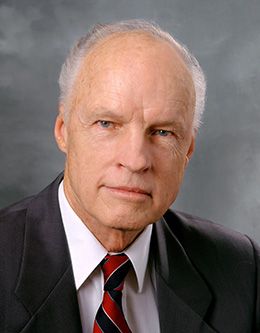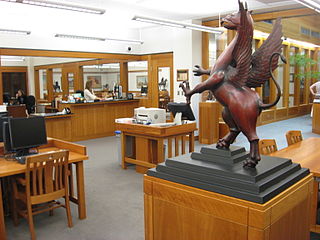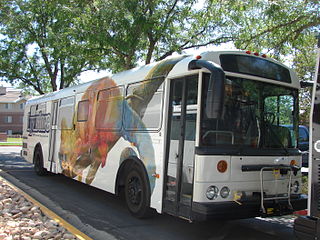
The BYU Testing Center is a student assessment center located in the Heber J. Grant Building at Brigham Young University.

The BYU Testing Center is a student assessment center located in the Heber J. Grant Building at Brigham Young University.
The Heber J. Grant Building was originally built as the BYU library. It was dedicated in 1925 by Heber J. Grant, the first building completed while Franklin S. Harris was president of BYU. The library was housed on the second floor, while the first floor contained classrooms. [1]
After the building of the Harold B. Lee Library the building was used as a museum by the College of Biology and Agriculture until this was moved to the Monte L. Bean Life Science Museum. [2] In 1982 the building began its use as the university's testing center.

The main portion of the Testing Center is a large main testing room, which originally served as BYU's library, and now is filled with approximately 650 desks. Students enter through the center's administration area. The center also has a few smaller rooms with even more desks (one of which, the music room, has soft classical music playing through wall-mounted speakers), study hall rooms downstairs for test preparation, and faculty offices.

When students exit the testing center, they can see their scores immediately on the BYU Testing Center website (for multiple-choice tests). Earlier, those taking multiple-choice tests waited for a moment or two in the administration area to receive a printout of their results, which usually resulted in the exit area being crowded.
In order to avoid long lines during finals, the testing center opens remote locations around campus. Generally, the Wilkinson Student Center (WSC) [3] serves all religion finals while the Joseph Smith Building (JSB) Auditorium is used for larger classes such as American Heritage. Lines are usually shortest before 11:00 AM, in the early afternoon, and after 7:00 PM.

Brigham Young University (BYU) is a private research university in Provo, Utah, United States. It was founded in 1875 by religious leader Brigham Young and is sponsored by the Church of Jesus Christ of Latter-day Saints.

Brigham Young University–Hawaii (BYU–Hawaii) is a private college in Laie, Hawaii. It is owned and operated by the Church of Jesus Christ of Latter-day Saints. BYU–Hawaii was founded in 1955 and it became a satellite campus of Brigham Young University (BYU) in 1974. In 2004, it was made a separate institution. The college's sole focus is on undergraduate education.

The J. Reuben Clark Law School is the law school of Brigham Young University (BYU) in Provo, Utah. Founded in 1973, the school is named after J. Reuben Clark, a former U.S. Ambassador, Undersecretary of State, and general authority of the institution's sponsoring organization, The Church of Jesus Christ of Latter-day Saints.

Ernest Leroy Wilkinson was an American academic administrator, lawyer, and prominent figure in the Church of Jesus Christ of Latter-day Saints. He was president of Brigham Young University (BYU) from 1951 to 1971, simultaneously overseeing the entire LDS Church Educational System (CES). He is credited with the expansion of BYU. Under his presidency, the student body increased six times to over 25,000 students due to the university's physical growth and his aggressive recruiting policies; the number of colleges at the university increased from five to thirteen, and the number of faculty members increased four-fold. Wilkinson focused on recruiting more faculty and convincing current faculty to receive education outside the university. As a result, the number of teachers with doctorate degrees increased from 50 to 500. Associate and doctoral programs were created for BYU.

Howard Stevenson McDonald was an American university administrator, and president of Brigham Young University and California State University, Los Angeles.

Franklin Stewart Harris was president of Brigham Young University (BYU) from July 1921 until June 1945, and president of Utah State University from 1945 to 1950. His administration was the longest in BYU history and saw the granting of the first master's degrees. Under his administration the school became an accredited university. He set up several colleges, such as the College of Fine and Performing Arts with Gerrit De Jong as the founding dean. Harris was an agricultural scientist, holding a doctorate in agronomy from Cornell University. He had served as the agriculture department head and head of the experiment station at Utah State Agricultural College and left BYU to become president of that institution. Harris also traveled to Russia and to Iran and other parts of the Middle East in order to provide expert advice on agriculture issues. The Harris Fine Arts Center on BYU's Provo campus was named after him.

Truman Grant Madsen was a professor of religion and philosophy at Brigham Young University (BYU) and director of the Brigham Young University Jerusalem Center for Near Eastern Studies. He was a prolific author, a recognized authority on Joseph Smith, and a popular lecturer among Latter-day Saints. At one point, Madsen was an instructor at the LDS Institute of Religion in Berkeley, California.
The history of Brigham Young University (BYU) begins in 1875, when the school was called Brigham Young Academy (BYA). The school did not reach university status until 1903, in a decision made by the school's board of trustees at the request of BYU president Benjamin Cluff. It became accredited during the tenure of Franklin S. Harris, under whom it gained national recognition as a university. A period of expansion after World War II caused the student body to grow many times in size, making BYU the largest private university of the time. The school's history is closely connected with its sponsor, The Church of Jesus Christ of Latter-day Saints.

The Franklin S. Harris Fine Arts Center (HFAC) was previously the main location for Brigham Young University's (BYU) College of Fine Arts and Communications (CFAC). In early 2023, the building was demolished to make way for a new arts building on the same site.
The main campus of Brigham Young University sits on approximately 560 acres (2.3 km2) nestled at the base of the Wasatch Mountains and includes 311 buildings. The buildings feature a wide variety of architectural styles, each building being built in the style of its time. The grounds and landscaping of the campus won first place in 2005 in America in Bloom's campus division. Furthermore, views of the Wasatch Mountains, can be seen from the campus. BYU's Harold B. Lee Library, which The Princeton Review ranked as the #1 "Great College Library" in 2004, has approximately 8½ million items in its collections, contains 98 miles (158 km) of shelving, and can seat 4,600 people. The Spencer W. Kimball Tower is home to several of the university's departments and programs and is the tallest building in Provo, Utah. Furthermore, BYU's Marriott Center, used as a basketball arena, can seat almost 18,000 and is one of the largest on-campus arenas in the nation.

The L. Tom Perry Special Collections is the special collections department of Brigham Young University (BYU)'s Harold B. Lee Library in Provo, Utah. Founded in 1957 with 1,000 books and 50 manuscript collections, as of 2016 the Library's special collections contained over 300,000 books, 11,000 manuscript collections, and over 2.5 million photographs, among many other rare and unique research materials. Since its inception, the special collections have been housed in numerous places including the crawl space of a university building and a wholesale grocery warehouse. Since 2016, the special collections have been located on the first floor of the Harold B. Lee Library and is considered to hold "the finest collection of rare books in the Intermountain West and the second finest Mormon collection in existence".
The Brigham Young University Student Service Association (BYUSA) is the official student association at Brigham Young University (BYU), located in Provo, Utah. Student government appeared at BYU as early as the 1900s. Throughout its existence, the student government took different forms. Up until 1933, the student government association was known as the student body, after which it was known as the Associated Students of Brigham Young University (ASBYU). During its early history the student body sought to provide students with campus events and forms of entertainment for its students; however, with the transition to ASBYU, the organization sought to not only provide for the social life of students but also seek to advocate for their needs. The structure of modern BYUSA includes a president and executive vice-president as well as four area vice-presidents in charge of a distinct sect of BYUSA which include Experiences, Clubs, Student Advisory Council, and Student Honor.

The Brigham Young University (BYU) College of Fine Arts and Communications (CFAC) is one of the nine colleges at the university, a private institution operated by the Church of Jesus Christ of Latter-day Saints and located in Provo, Utah. Founded in 1925, the college has grown from a small college of the arts with minimal faculty and only 100 students to the second largest college on campus.
The BYU Division of Continuing Education (DCE) is a division of Brigham Young University (BYU) that oversees continuing education programs.

The Ernest L. Wilkinson Student Center (WSC) serves as the main center on Brigham Young University (BYU) Campus. It was originally called the Ernest L. Wilkinson Center but was renamed to its current name at its re-dedication by Gordon B. Hinckley in 1999 after the building had been extensively renovated. It is known by students as "The Wilk".
BYU has a broad array of bands and ensembles. Most of which are a part of the programs of the School of Music in the BYU College of Fine Arts and Communications, primarily either in the Department of Bands or the Jazz Studies Department.

The Ryde is a bus service that provides transportation to the Brigham Young University (BYU) community in Provo, Utah, United States. The service is owned and operated by Student Movement, Inc. (SMI) and operates under the brand, "The Ryde". Although The Ryde began as a limited service paid shuttle bus, in the fall of 2015 it expanded to limited-service bus routes that are free to BYU students.

The Harold B. Lee Library (HBLL) is the main academic library of Brigham Young University (BYU) located in Provo, Utah. The library started as a small collection of books in the president's office in 1876 before moving in 1891. The Heber J. Grant Library building was completed in 1925, and in 1961 the library moved to the newly constructed J. Reuben Clark Library where it stands today. That building was renamed to the Harold B. Lee Library in 1974.